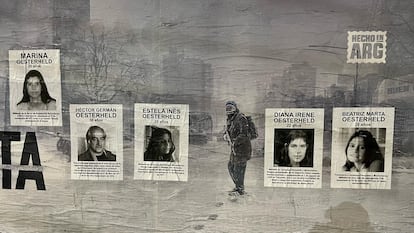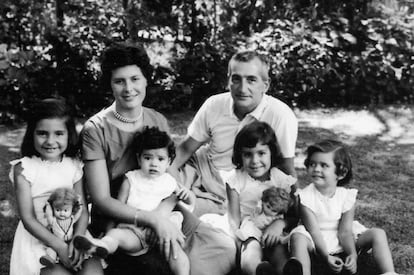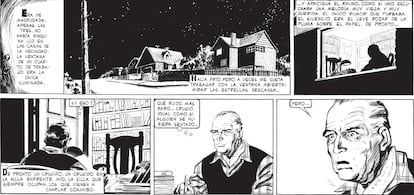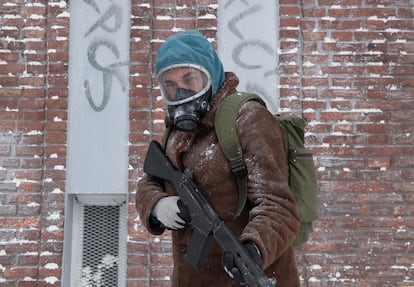The family drama, the repression of the Argentine dictatorship, and the delicate legacy hidden in 'The Eternalist'

In secret, from phone booths, at the age of 58, screenwriter Héctor Germán Oesterheld , one of Latin America's most famous creators thanks to, among other comics, El eternauta, dictated the installments of El eternauta II so that cartoonist Francisco Solano López could progress with the work, before being devoured by the repressive apparatus of the Argentine dictatorship on April 27, 1977. They allowed him to say goodbye to his eldest grandson, Martín Mórtola Oesterheld, who at three years old became the last person in his family to see the comics legend. "I don't remember my parents' faces, but I do remember being with my grandfather, his physical contact," explains Oesterheld in Madrid.
The military dictatorship had already murdered the screenwriter's four daughters, aged between 19 and 25, two of them pregnant, and three of his sons-in-law. All were Montonero militants. Only Elsa Sánchez, the writer's ex-wife, who took care of Martín, and another grandson, Fernando, aged one, who was raised by his paternal grandparents, survived. The legacy of El eternauta was left in his hands, and after Elsa Sánchez's death in 2015, Martín Oesterheld (51 years old) has cared for and fought for the comic's reissue, after finding the original pages and finally managing to bring an audiovisual adaptation to fruition in the form of a Netflix series, of which a second season has been confirmed.
How do you handle such a legacy? How do you defend a masterpiece, considered one of the great graphic novels of the 20th century and the most influential in Spanish? "By honoring it and understanding that it has very different interpretations," explains Martín Oesterheld. “It was published in installments from 1957 to 1959 in the magazineHora Cero Semanal , and it talked about what was happening at that time in Argentina. But it reaches other perspectives because it talks about dictatorships, and that trauma even affected our own families two decades later. Or how the protagonists want to find their loved ones, and that transports us to the disappeared... You can see it as a story of an alien invasion, and you can immerse yourself in a more complex world. In addition to being a work of adventure and science fiction, it approaches these genres from a peripheral perspective—our own—which breaks with the preconceived idea that dystopias can only exist in New York or London. With the premiere of the series, you have no idea how many kids are reading it. It's a classic to the extent that you can continue to reinterpret its meaning; it's a transgenerational classic.”

And, at the same time, El eternauta is Oesterheld. “My grandfather didn't just decide that the protagonists would be Argentinian in Greater Buenos Aires; the house of the main character, Juan Salvo, was his own house in Beccar,” recalls his grandson. Those familiar with the comic and the series know that the character Oesterheld had kept to himself, and that his interrelation with Juan Salvo gives meaning to the title, has disappeared. “That's why some English-speaking critics don't understand the reason for his name,” Martín smiles. “Luckily, with the recovery of the original pages, in the hands of an Italian collector, we were finally able to publish it properly in the English-speaking market in 2015, and that opened many doors for us.”
The original 350-page black-and-white book underwent numerous changes and deletions in a 1961 reissue, and these tweaks have been reproduced ever since. In 2011, a new edition was printed using the original material kept by a collector in Italy, restoring the comic to its original splendor... except for 34 pages that are still missing. Two more have surfaced since the series' premiere: they were kept by the widow of a cartoonist "who was waiting to return them to an Oesterheld."

After a bomb exploded in the garage of Beccar's house, Elsa Sánchez took all of her ex-partner's material home with her. "There wasn't a specific day when I decided to read The Eternalauta. It was a continuum. I played with the books and notes my grandmother had been able to rescue. And when I grew up, my playground was that back room of the house, where my grandfather's memory was kept. It was my point of contact with the past."
Oesterheld recalls how a bookshelf collapsed from the sheer weight of the paper. “I began reading that pile of books, and so, little by little, I became closer to my grandfather's inner life, his knowledge of English literature, his relationship with Borges…” he notes. “In my story, the intimate, the private, and the public are interwoven. Those fallen books are the private; the public is the echo of this carefully curated reissue and of the series. And the intimate… Every March 24th [National Day of Remembrance for Truth and Justice in Argentina] many people come out with photos of their missing loved ones. I feel that as more intimate.” Obviously, he's also seen the series' advertisements, which have been pasted with photos of his grandfather, his aunts, and his mother. “My grandmother was part of the Grandmothers of the Plaza de Mayo and searched for those grandchildren who could have been born, if they exist, if they were born... I don't want to over-explain the issue, but for my grandmother, she was a driving force. She was a true soul, very Celtic, because her parents were from Pontevedra. She endured all that pain and also cared for me with love.” Of the missing members of the family, only the body of the youngest, Beatriz, was recovered.

The journey to the big screen has also been long, fraught with dangers that Oesterheld, an audiovisual producer who appears in the series as executive producer, and his wife, Laura Bruno, have overcome. In his account, he thanks his colleagues on this journey, recalling the approaches of Spaniard Adán Aliaga (who would eventually make a documentary about his grandmother, La mujer del eternauta) and Argentine Lucrecia Martel. “Another one who approached me was actor Jeremy Renner. He was a huge fan, but he wanted to move the action to the US and shoot it in English. There, we couldn't compromise. On the other hand, Netflix understood.”

Martín Oesterheld takes a step forward and takes responsibility for one of the main changes: bringing the story up to date. He explains: “I liked the concept of Juan Salvo as a survivor, driven by the logic of a second chance. And there's the Malvinas generation, which has been largely ignored. When Salvo's age was increased and Ricardo Darín came on board, a choice proposed by producer Matías Mosteirín and director Bruno Stagnaro, the whole puzzle fell into place.”
EL PAÍS





